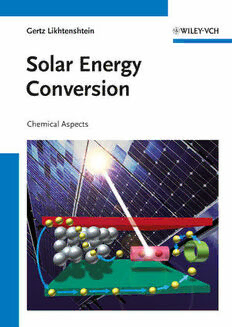
Solar Energy Conversion: Chemical Aspects PDF
Preview Solar Energy Conversion: Chemical Aspects
Gertz Likhtenshtein Solar Energy Conversion Related Titles Strehmel,B.,Strehmel,V.,Malpert,J.H. Pagliaro,M.,Palmisano,G.,Ciriminna,R. Applied and Industrial Flexible Solar Cells Photochemistry 2008 2012 ISBN:978-3-527-32375-3 ISBN:978-3-527-32668-6 De Vos,A. Scheer,R.,Schock,H.-W. Thermodynamics of Solar Chalcogenide Photovoltaics Energy Conversion Physics,Technologies,andThinFilmDevices 2008 2011 ISBN:978-3-527-40841-2 ISBN:978-3-527-31459-1 Brabec,C.,Scherf,U.,Dyakonov,V.(Eds.) Alkire, R. C., Kolb, D. M., Lipkowski, J., Organic Photovoltaics Ross, P. (Eds.) Materials,DevicePhysics, and Manufacturing Photoelectrochemical Materials Technologies and Energy Conversion 2008 Processes ISBN:978-3-527-31675-5 2010 ISBN:978-3-527-32859-8 Würfel, P. Physics of Solar Cells FromBasicPrinciplestoAdvanced Concepts 2009 ISBN:978-3-527-40857-3 Gertz Likhtenshtein Solar Energy Conversion Chemical Aspects TheAuthor AllbookspublishedbyWiley-VCHarecarefully produced.Nevertheless,authors,editors,andpub- Prof.GertzLikhtenshtein lisherdonotwarranttheinformationcontainedin DepartmentofChemistry thesebooks,includingthisbook,tobefreeoferrors. BenGurionUniversity Readersareadvisedtokeepinmindthatstatements, P.O.Box653 data,illustrations,proceduraldetailsorotheritems 84105Beer-Sheva mayinadvertentlybeinaccurate. Israel LibraryofCongressCardNo.: appliedfor BritishLibraryCataloguing-in-PublicationData Acataloguerecordforthisbookisavailablefromthe BritishLibrary. Bibliographicinformationpublishedby theDeutscheNationalbibliothek TheDeutscheNationalbibliothekliststhispublica- tionintheDeutscheNationalbibliografie;detailed bibliographicdataareavailableontheInternetat http://dnb.d-nb.de. #2012Wiley-VCHVerlag&Co.KGaA, Boschstr.12,69469Weinheim,Germany Allrightsreserved(includingthoseoftranslationinto otherlanguages).Nopartofthisbookmayberepro- ducedinanyform–byphotoprinting,microfilm, oranyothermeans–nortransmittedortranslated intoamachinelanguagewithoutwrittenpermission fromthepublishers.Registerednames,trademarks, etc.usedinthisbook,evenwhennotspecifically markedassuch,arenottobeconsideredunprotected bylaw. Composition ThomsonDigital,Noida,India PrintingandBinding MarkonoPrintMediaPteLtd, Singapore CoverDesign SchulzGrafik-Design,Fußgönheim PrintedinSingapore Printedonacid-freepaper PrintISBN: 978-3-527-32874-1 V Contents Preface IX 1 ElectronTransferTheories 1 1.1 Introduction 1 1.2 TheoreticalModels 1 1.2.1 BasicTwoStatesModels 1 1.2.1.1 Landau–ZenerModel 1 1.2.1.2 MarcusModel 3 1.2.1.3 ElectronicandNuclearQuantumMechanicalEffects 5 1.2.2 FurtherDevelopmentsintheMarcusModel 7 1.2.2.1 ElectronCoupling 7 1.2.2.2 DrivingForceandReorganizationEnergy 9 1.2.3 ZusmanModelanditsDevelopment 17 1.2.4 EffectofNonequilibrityonDrivingForceandReorganization 21 1.2.5 Long-RangeElectronTransfer 24 1.2.6 SpinEffectsonChargeSeparation 28 1.2.7 Electron–ProtonTransferCoupling 29 1.2.8 SpecificityofElectrochemicalElectronTransfer 33 1.3 ConcertedandMultielectronProcesses 38 References 40 2 PrincipalStagesofPhotosyntheticLightEnergyConversion 45 2.1 Introduction 45 2.2 Light-HarvestingAntennas 46 2.2.1 General 46 2.2.2 BacterialAntennaComplexProteins 47 2.2.2.1 TheStructureoftheLight-HarvestingComplex 47 2.2.2.2 DynamicProcessesinLHC 48 2.2.3 PhotosystemsIandIIHarvestingAntennas 49 2.3 ReactionCenterofPhotosyntheticBacteria 53 2.3.1 Introduction 53 2.3.2 StructureofRCPB 56 2.3.3 KineticsandMechanismofElectronTransferinRCPB 58 VI Contents 2.3.4 ElectronTransferandMolecularDynamicsinRCPB 64 2.4 ReactionCentersofPhotosystemsIandII 68 2.4.1 ReactionCentersofPSI 69 2.4.2 ReactionCenterofPhotosystemII 72 2.5 WaterOxidationSystem 76 References 84 3 PhotochemicalSystemsoftheLightEnergyConversion 91 3.1 Introduction 91 3.2 ChargeSeparationinDonor–AcceptorPairs 92 3.2.1 Introduction 92 3.2.2 CyclicTetrapyrroles 93 3.2.3 MiscellaneousDonor–AcceptorSystems 101 3.2.4 PhotophysicalandPhotochemicalProcessesinDual Flourophore–NitroxideMolecules(FNO) 106 3.2.4.1 System1 107 3.2.4.2 Systems2 109 3.3 ElectronFlowthroughProteins 113 3.3.1 FactorsAffectingLightEnergyConversioninDual Fluorophore–NitroxideMoleculesinaProtein 116 3.3.2 PhotoinducedInterlayerElectronTransferinLipidFilms 118 References 121 4 RedoxProcessesonSurfaceofSemiconductorsandMetals 127 4.1 RedoxProcessesonSemiconductors 127 4.1.1 Introduction 127 4.1.2 InterfacialElectronTransferDynamicsinSensitizedTiO 127 2 4.1.3 ElectronTransferinMiscellaneousSemiconductors 130 4.1.3.1 Single-MoleculeInterfacialElectronTransferin Donor–Bridge–NanoparticleAcceptorComplexes 130 4.1.4 RedoxProcessesonCarbonMaterials 133 4.2 RedoxProcessesonMetalSurfaces 136 4.3 ElectronTransferinMiscellaneousSystems 144 References 147 5 Dye-SensitizedSolarCellsI 151 5.1 GeneralInformationonSolarCells 151 5.2 Dye-SensitizedSolarCells 153 5.2.1 General 153 5.2.2 PrimaryGrätzelDSSC 155 5.3 DSSCComponents 158 5.3.1 Sensitizers 158 5.3.1.1 RutheniumComplexes 158 5.3.1.2 Metalloporphyrins 159 5.3.1.3 OrganicDyes 161 Contents VII 5.3.1.4 SemiconductorSensitizes 167 5.3.2 Photoanode 168 5.3.3 InjectionandRecombination 171 5.3.4 ChargeCarrierSystems 175 5.3.5 Cathode 182 5.3.6 Solid-StateDSSC 185 References 189 6 Dye-SensitizedSolarCellsII 199 6.1 OpticalFiberDSSC 199 6.2 TandemDSSC 202 6.3 QuantumDotSolarCells 208 6.4 PolymersinSolarCells 211 6.5 FabricationofSolarCellComponents 219 6.6 Fullerene-BasedSolarCells 223 References 229 7 PhotocatalyticReductionandOxidationofWater 235 7.1 Introduction 235 7.2 PhotocatalyticDihydrogenProduction 236 7.2.1 PhotocatalyticH EvolutionoverTiO 236 2 2 7.2.2 MiscellaneousSemiconductorPhotocatalystsforH Evolution 237 2 7.2.3 PhotocatalyticH EvolutionfromWaterBasedonPlatinumand 2 PalladiumComplexes 240 7.3 WaterSplittingintoO2andH2 241 7.3.1 ThermodynamicsandFeasableMechanismoftheWaterSplitting 241 7.3.2 MnClustersasWaterOxidizingPhotocatalysts 242 7.3.2.1 StructureandCatalyticActivityofCubaneManganeseClusters 242 7.3.2.2 CatalyticActivityandMechanismofWOSinManganeseClusters 244 7.3.3 HeterogeneousCatalystsforWOS 248 7.3.3.1 General 248 7.3.3.2 PhotocatalystsBasedonTitaniumOxides 250 7.3.3.3 MiscellaneousSemiconductorsfortheWOSCatalysis 251 References 256 Conclusions 261 References 263 Index 265 IX Preface Worldenergyconsumptionisabout4.71020Jandisexpectedtogrowattherateof 2% each year for the next 25 years. Since the emergence of the apparition of the impendingenergycrises,variousavenuesarebeingexploredtoreplacefossilfuels withrenewableenergyfromsolarpower.Inthepastdecades,thedevelopmentof advanced molecular materials and nanotechnology, solar cells, and dye-sensitized solarcells,firstofall,hasinitiatedanewsetofideasthatcandramaticallyimprove energyconversionefficiencyandreducepricesofalternativeenergysources.Never- theless,therearemanyfundamentalproblemstobesolvedinthisarea.Commercial competitionofthenewmaterialswithexistingfossilenergysourcesremainsoneof themostchallengingproblemsformankind. Thisbookembracesallprincipalaspectsofstructureandphysicochemicalaction mechanisms of dye-sensitized collar cells (DSSCs) and photochemical systems of light energyconversionand related areas. Alargebodyofliterature exists onthis subjectandmanyscientistshavemadeimportantcontributionstothisthefield.The InternetprogramSkiFindershows44979referencesfor“dyesensitized”and8493 referencesfor‘‘dye-sensitizedcollarcells.’’Itisimpossibleinthespaceallowedin thisbooktogivearepresentativesetofreferences.Theauthorapologizestothosehe hasnotbeenabletoinclude.Morethan1000referencesaregiveninthebook,which shouldprovideakeytoessentialrelevantliterature. Chapter 1 of the monograph is a brief outline of the contemporary theories of electrontransferindonor–acceptorpairsandbetweenadyeandasemiconductor. Principalstagesoflightenergyconversioninbiologicalphotosystems,inwhichthe Naturedemonsratesexcellentexamplesforsolvingproblemsofconversionoflight energy to energy of chemical compounds, are described in Chapter 2. The light energy conversion in donor–acceptor pairs in solution and on templates is the subjectofChapter3.Chapter4describesredoxprocessesonthesurfaceofsemi- conductorsandmetals.Chapters1–4formthetheoreticalandexperimentalback- groundforthecentralChapters5and6.InChapter5,ageneralsurveyismadeof fundamentalsoftheprimaryGertzeldye-sensitizedsolarcellanditsrapiddevelop- ment.Advantagesindesignofnewtypeofdye-sensitizedsolarcellssuchasoptical fiber,tandem,andsolid-stateDSSCandfabricationofitscomponentsarereviewed in Chapter 6. Chapter 7 gathers information on recent progress made in photo- catalyticreductionandoxidationofwater. X Preface The monograph isintended for scientists and engineers working ondye-sensi- tizedcollarcellsandothermolecularsystemsoflightenergyconversionandrelated areassuchasphotochemistryandphotosynthesisanditschemicalmimicking.The book can be used as a subsidiary manual for instruction for graduate and under- graduatestudentsofuniversitychemistry,physics,andbiophysicsdepartments. GertzLikhtenshtein j 1 1 Electron Transfer Theories 1.1 Introduction Electrontransfer(ET)isoneofthemostubiquitousandfundamentalphenomenain chemistry,physics,andbiology[1–34].NonradiativeandradiativeETarefoundtobea keyelementarystepinmanyimportantprocessesinvolvingisolatedmoleculesand supermolecules, ionsand excesselectrons insolution, condensedphase, surfaces andinterfaces,electrochemicalsystemsandbiology,andinsolarcells,inparticular. As a light microscopic particle, an electron easily tunnels through a potential barrier.Therefore,theprocessisgovernedbythegeneraltunnelinglawformulated byGamov[35].TheprincipaltheoreticalcornerstoneforcondensedphaseETwaslaid byFranckandLibby(1949–1952)whoassertedthattheFranck–Condonprincipleis applicable not only to the vertical radiative processes but also to nonradiative horizontalelectrontransfer.ThenextdecisivestepinthefieldwastakenbyMarcus andhiscolleagues[2,17,36]andHash[37].Theseauthorsarticulatedtheneedfor readjustmentofthecoordinationshellsofreactantsinself-exchangereactionsandof thesurroundingsolventtotheelectrontransfer.Theyalsoshowedthattheelectronic interactionofthereactantsgivesrisetothesplittingattheintersectionofthepotential surfaces,whichleadstoadecreaseintheenergybarrier. 1.2 TheoreticalModels 1.2.1 BasicTwoStatesModels 1.2.1.1 Landau–ZenerModel The nonadiabatic electron transfer between donor (D) and acceptor (A) centers is treatedbytheFermisgoldenrule(FGR)[38] SolarEnergyConversion.ChemicalAspects,FirstEdition.GertzLikhtenshtein. (cid:2)2012Wiley-VCHVerlagGmbH&Co.KGaA.Published2012byWiley-VCHVerlagGmbH&Co.KGaA.
